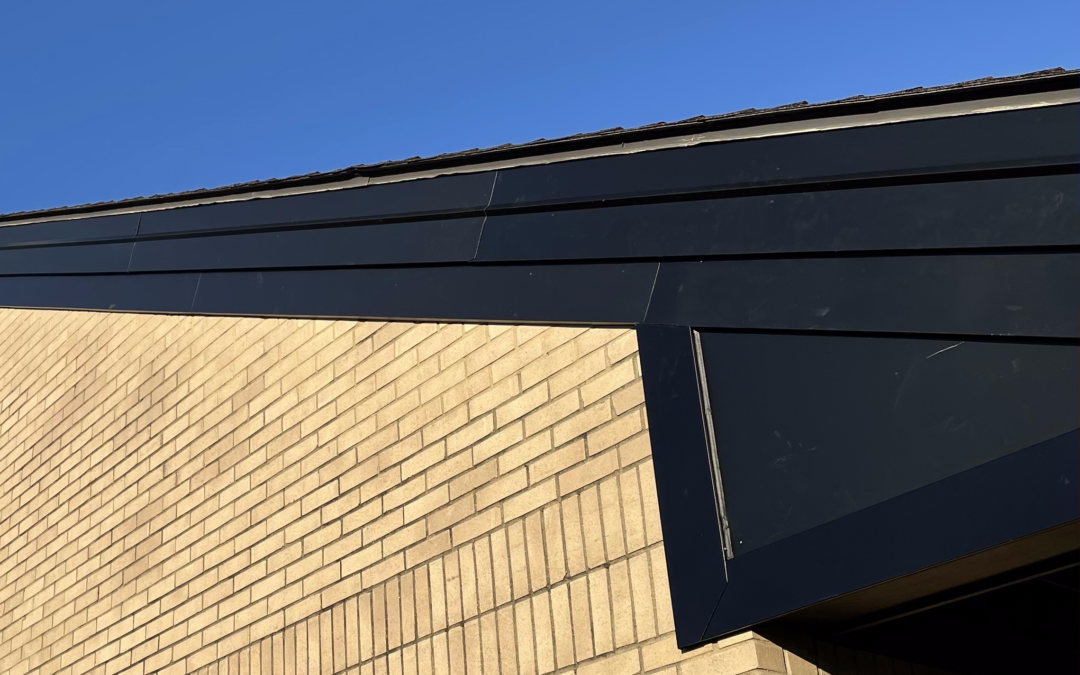When it comes to enhancing your home’s exterior, one key component that often goes overlooked is the soffit. Here, we provide a comprehensive, purely informational guide on vinyl soffit, its benefits, installation process, maintenance tips, and more. Tiger Gutters, based in Memphis, TN, is dedicated to sharing industry insights without making any commitments or promises—our goal is simply to inform and educate.
What is Vinyl Soffit?
Vinyl soffit is a material used to cover the underside of your roof’s overhang. Typically installed on the eaves, vinyl soffit helps protect your home’s structural components from weather-related damage while providing a finished, clean look. Unlike traditional wood or metal soffit, vinyl is appreciated for its durability, low maintenance requirements, and resistance to common issues like rot and corrosion.
Key Characteristics:
- Durability: Vinyl is designed to withstand various weather conditions, making it a long-lasting option.
- Low Maintenance: It does not require frequent painting or sealing.
- Versatility: Available in multiple colors and styles to match different home designs.
- Cost-Effective: Often more budget-friendly compared to other soffit materials.
The Benefits of Vinyl Soffit
Understanding the advantages of vinyl soffit can help homeowners make an informed decision about its use in their home projects. Here are some of the primary benefits:
1. Enhanced Aesthetic Appeal
Vinyl soffit contributes to a sleek, modern look by neatly covering the underside of your roof overhang. It can complement a range of architectural styles—from traditional to contemporary—enhancing overall curb appeal.
2. Improved Ventilation
Many vinyl soffit systems are designed with built-in ventilation. Proper ventilation helps regulate attic temperature, which can contribute to energy efficiency and prolong the lifespan of your roof.
3. Resilience to Weather Elements
Vinyl is resistant to the effects of moisture, insects, and UV rays. This resilience makes it an excellent choice for areas with high humidity or extreme weather fluctuations, such as Memphis, TN.
4. Ease of Installation
Vinyl soffit is lightweight and relatively simple to install, making it a popular option for DIY projects and professional installations alike. Its design often includes interlocking panels or continuous boards that simplify the process.
5. Energy Efficiency
By facilitating better attic ventilation, vinyl soffit can help maintain a more consistent indoor temperature. This can indirectly contribute to reduced energy costs, although actual savings vary depending on several factors.
Exploring Types and Styles of Vinyl Soffit
Vinyl soffit comes in various forms, allowing homeowners to choose a style that best matches their property’s design. Below are some common types:
Perforated Vinyl Soffit
Designed with small holes for ventilation, perforated vinyl soffit is particularly popular in climates where air circulation is crucial. These perforations allow air to flow freely, reducing moisture buildup and heat retention in the attic.
Solid Vinyl Soffit
This option offers a smooth, uninterrupted look without the perforations. While it does not provide the same level of ventilation as its perforated counterpart, it can be ideal for areas where ventilation is less of a concern or where a more uniform appearance is desired.
Customizable Designs
Some vinyl soffit products come with a range of color options and textures, enabling homeowners to tailor the look to their specific aesthetic preferences. These products can mimic the appearance of traditional materials like wood while offering the benefits of vinyl.
The Installation Process: What to Expect
While this guide is purely informational, understanding the general steps involved in installing vinyl soffit can be helpful when planning a home improvement project. Here’s an overview of the process:
- Inspection and Preparation:
Before installation, the underside of the roof overhang should be inspected for any damage or necessary repairs. Preparing the area ensures a smooth installation process. - Measuring and Planning:
Accurate measurements are critical. Homeowners need to determine the length and width of the soffit area to purchase the appropriate amount of material. - Installation of Ventilation (if applicable):
For perforated vinyl soffit, planning for adequate ventilation is key. This may involve installing vented panels or additional vent components along the soffit. - Attachment:
Vinyl soffit panels are typically secured using specialized fasteners or clips. The design of the panels often allows for a straightforward, interlocking installation method. - Finishing Touches:
After the panels are in place, any necessary caulking or trimming is applied to create a seamless, finished look.
Understanding these steps can help homeowners discuss their projects more knowledgeably with contractors or even consider a DIY approach if they have the requisite skills.
Maintenance and Care for Vinyl Soffit
One of the most appreciated features of vinyl soffit is its low maintenance requirement. However, proper care ensures longevity and optimal performance. Here are some maintenance tips:
- Regular Cleaning:
Use a mild detergent and a soft brush or cloth to remove dirt and debris. Avoid harsh chemicals that could damage the material. - Inspection for Damage:
Periodically inspect the soffit for any signs of cracking or warping. Early detection can prevent more significant issues later on. - Ensure Unobstructed Ventilation:
For perforated options, make sure that the ventilation holes remain free from blockages like leaves or nest materials. This is key to maintaining proper airflow. - Professional Consultation:
While many maintenance tasks can be performed by homeowners, consulting a professional for periodic inspections can help catch issues that might otherwise be overlooked.
Cost Considerations and Longevity
Investing in vinyl soffit can be a cost-effective solution for many homeowners. The upfront costs are generally lower compared to traditional materials, and the long-term savings on maintenance and repairs can be significant. When considering vinyl soffit, keep the following in mind:
- Material Costs:
Vinyl is often priced competitively with other soffit materials. The actual cost can vary based on quality, brand, and specific design features. - Installation Costs:
For those who opt to hire professionals, installation costs should be factored into the overall budget. DIY installations can reduce these expenses, provided you have the necessary skills and tools. - Long-Term Durability:
Due to its resistance to weather-related damage, vinyl soffit typically offers a longer lifespan with fewer maintenance requirements. This durability makes it an attractive option for homeowners looking for a long-term solution.
Vinyl Soffit Compared to Other Materials
When choosing a soffit material, it’s useful to compare vinyl to other common options:
Wood Soffit
- Pros: Offers a traditional aesthetic with natural charm.
- Cons: Requires regular maintenance, including painting and sealing to prevent rot and insect damage.
Aluminum Soffit
- Pros: Durable and resistant to rust.
- Cons: Can dent or scratch more easily than vinyl and may require occasional repainting to maintain its appearance.
Fiber Cement Soffit
- Pros: Highly durable and fire-resistant.
- Cons: Heavier than vinyl and typically more expensive to install.
Overall, vinyl soffit stands out for its balance of cost, durability, and minimal upkeep, making it a favored choice for many homeowners.
Frequently Asked Questions About Vinyl Soffit
Q1: Is vinyl soffit suitable for all climates?
A: Vinyl soffit is designed to be durable and weather-resistant, making it suitable for a wide range of climates. However, factors like extreme temperature variations or local environmental conditions should be considered when selecting any building material.
Q2: How often should vinyl soffit be cleaned?
A: Regular cleaning—ideally once or twice a year—helps maintain the appearance and functionality of vinyl soffit. More frequent cleaning might be necessary in areas with heavy dust or pollution.
Q3: Can I install vinyl soffit myself?
A: Many homeowners find that vinyl soffit is relatively straightforward to install due to its lightweight nature and interlocking design. However, having a clear understanding of the installation process is essential, and professional assistance might be beneficial for those who are less experienced.
Q4: How does vinyl soffit contribute to home ventilation?
A: Perforated vinyl soffit is specifically designed to facilitate airflow in the attic, which can help regulate temperature and reduce the risk of moisture buildup—factors that contribute to the overall health of your home’s structure.
Final Thoughts
Vinyl soffit offers an appealing combination of durability, low maintenance, and aesthetic versatility. This guide has provided an in-depth look at what vinyl soffit is, its benefits, installation nuances, maintenance tips, and comparisons with other materials. While the information presented here is designed solely to inform, understanding these factors can help you make more educated decisions about your home improvement projects. Tiger Gutters of Memphis, TN, hopes that this detailed guide serves as a valuable resource for anyone considering vinyl soffit as part of their home’s exterior design.

